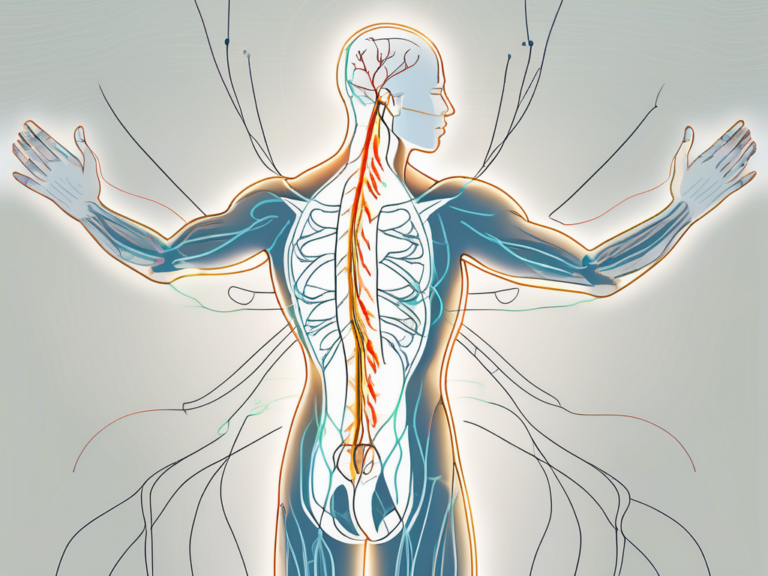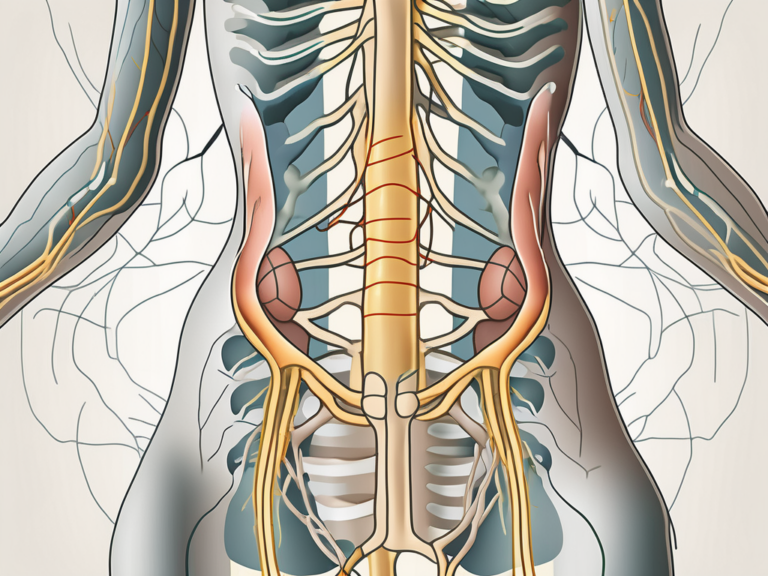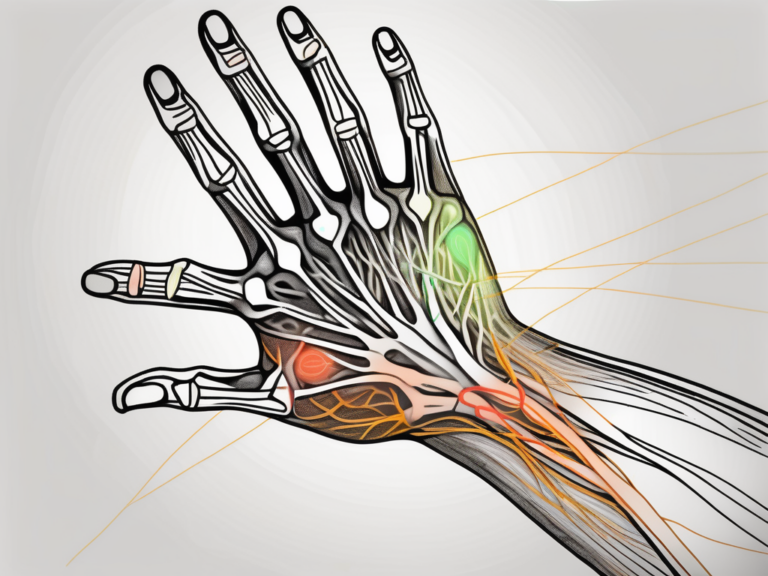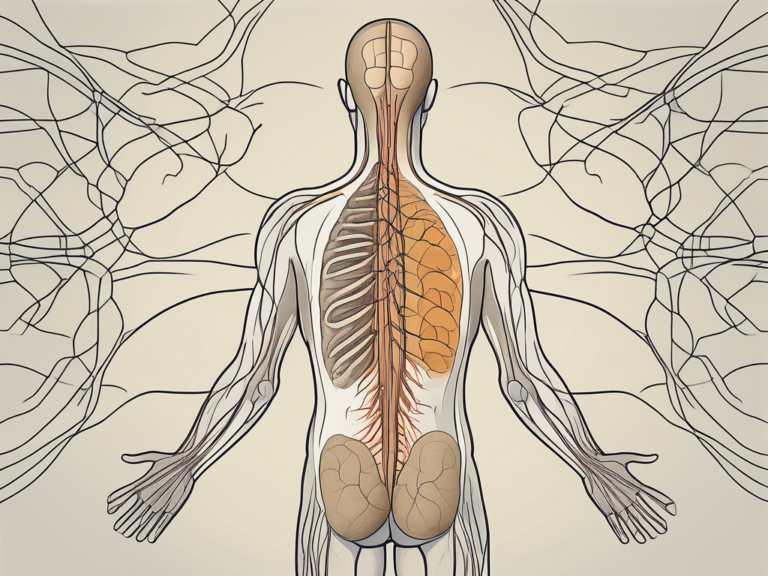How to Locate Where the Sacral Nerve Exits from the Spine
The sacral nerve is a critical component of the spinal cord, responsible for transmitting sensory and motor signals from the lower body to the brain. Understanding its precise location is essential for diagnosing and treating certain medical conditions. In this article, we will explore the anatomy of the spine, tools and techniques for locating the sacral nerve, steps involved in the procedure, safety measures and precautions, interpreting the results, and frequently asked questions about the sacral nerve.
Understanding the Anatomy of the Spine
Before attempting to locate the sacral nerve, one must have a basic understanding of the spinal cord’s anatomy. The spine, also known as the vertebral column, is a complex structure that provides support and protection for the spinal cord. It is divided into several sections, including the cervical, thoracic, lumbar, and sacral regions. Each section consists of a specific number of vertebrae, which are the individual bones that make up the spine.
The cervical region, located in the neck, consists of seven vertebrae. These vertebrae are smaller in size compared to the others and allow for a wide range of motion in the neck. The thoracic region, found in the upper back, is composed of twelve vertebrae that connect to the ribs, providing stability and protection for the vital organs in the chest. The lumbar region, situated in the lower back, consists of five vertebrae that support the weight of the upper body and enable movements such as bending and twisting. Finally, the sacral region, located at the lower end of the vertebral column, is formed by the fusion of five vertebrae known as the sacrum.
The sacrum, a triangular-shaped bone, is situated between the lumbar spine and the coccyx, commonly known as the tailbone. It provides a framework for the pelvis and plays a crucial role in connecting the upper body to the lower body. The sacrum also serves as an attachment point for various muscles and ligaments, contributing to overall stability and mobility.
The Role of the Sacral Nerve
The sacral nerves emerge from the sacrum and form the sacral plexus, a network of nerves that supplies the lower back, buttocks, pelvic region, and lower limbs. These nerves play a vital role in transmitting sensory information from these areas to the brain. They allow us to perceive touch, pain, and temperature, providing us with a sense of our surroundings and potential dangers.
In addition to sensory functions, the sacral nerves also control motor functions in the lower body. They are responsible for initiating and coordinating muscle movements, allowing us to walk, run, jump, and perform various physical activities. The sacral nerves also play a role in reflexes, which are automatic responses to certain stimuli. For example, when you touch a hot surface, the sacral nerves quickly send signals to your muscles to withdraw your hand, preventing further injury.
Identifying Key Spinal Landmarks
Locating the sacral nerve requires identifying specific landmarks on the spine. One of these landmarks is the spinous processes, which are bony projections that can be felt along the back of the spine. These processes serve as reference points, allowing healthcare professionals to identify the position of the vertebrae and the surrounding structures.
The sacral nerve exits the spine through the sacral foramina, which are small openings located on each side of the sacrum. These foramina provide a pathway for the nerves to pass through and extend into the pelvic region. By carefully palpating the spinous processes and locating the sacral foramina, healthcare professionals can accurately identify the position of the sacral nerve and perform procedures or treatments specific to that area.
Understanding the anatomy of the spine, including the sacral region and its associated nerves, is essential for healthcare professionals involved in diagnosing and treating conditions related to the lower back, buttocks, pelvic region, and lower limbs. By having a comprehensive knowledge of the spine’s structure and function, healthcare professionals can provide effective care and improve the overall well-being of their patients.
Tools and Techniques for Locating the Sacral Nerve
When it comes to locating the sacral nerve, there are several tools and techniques that medical professionals can employ. These methods not only aid in pinpointing the exact location of the nerve but also provide valuable insights into the patient’s overall spinal health.
One of the most commonly used tools in this process is medical imaging. Techniques such as X-rays, magnetic resonance imaging (MRI), and computed tomography (CT) scans offer detailed images of the spine’s structure. These images allow doctors to visualize the exit points of the sacral nerve, providing a clear picture of its location within the intricate network of the spinal column.
Let’s delve deeper into the different medical imaging techniques that are utilized:
X-rays
X-rays are a fundamental tool in the field of radiology. When it comes to locating the sacral nerve, X-rays provide a two-dimensional image of the spine. This allows doctors to assess the alignment of the vertebrae and identify any abnormalities that may be affecting the sacral nerve’s pathway.
While X-rays offer a basic visual representation, they may not provide the level of detail required for a comprehensive analysis of the sacral nerve. This is where more advanced imaging techniques come into play.
Magnetic Resonance Imaging (MRI)
MRI scans utilize powerful magnets and radio waves to create detailed images of the body’s internal structures. When it comes to locating the sacral nerve, an MRI scan offers a high-resolution view of the spinal column, nerves, discs, and other structures. This level of detail allows doctors to precisely identify the exit points of the sacral nerve and assess any potential issues that may be affecting its function.
Additionally, MRI scans can provide insights into the overall health of the spine, helping doctors determine if there are any underlying conditions or abnormalities that may be contributing to the patient’s symptoms.
Computed Tomography (CT) Scans
CT scans combine X-ray technology with computer processing to create cross-sectional images of the body. These images offer a more detailed view of the spinal column, allowing doctors to visualize the sacral nerve and its surrounding structures from multiple angles.
CT scans are particularly useful when it comes to identifying bony abnormalities, such as fractures or tumors, that may be impacting the sacral nerve’s pathway. By obtaining a comprehensive understanding of the patient’s spinal anatomy, doctors can develop targeted treatment plans to address any issues affecting the sacral nerve.
While medical imaging techniques provide valuable insights, they are often complemented by physical examination methods to ensure a comprehensive evaluation of the sacral nerve’s location.
Physical examination methods involve a thorough assessment of the patient’s physical condition, as well as specific tests to evaluate neurological function. These methods include:
- Palpating the spinous processes to identify any abnormalities or areas of tenderness.
- Performing tests to assess the patient’s range of motion, muscle strength, reflexes, and sensation in the lower body. These tests provide valuable information about the functionality of the sacral nerve and its impact on the patient’s overall mobility.
- Evaluating the patient’s symptoms and medical history to gain a comprehensive understanding of their condition and potential underlying causes.
By combining the insights gained from medical imaging techniques with the information gathered through physical examination methods, medical professionals can accurately identify the location of the sacral nerve. This comprehensive approach ensures that patients receive the most effective and targeted treatment for their specific condition.
Steps to Locate the Sacral Nerve
Locating the sacral nerve involves a series of steps that should be performed by a qualified healthcare professional specialized in spinal anatomy and procedures. The process requires precision and expertise to ensure accurate placement and minimize potential risks.
Preparing for the Procedure
Prior to the sacral nerve locating procedure, the patient is typically required to undergo a comprehensive medical evaluation, including a physical examination and imaging studies. This evaluation ensures that the procedure is appropriate for the patient’s specific needs and helps minimize potential risks. It is crucial to disclose any previous surgeries, allergies, or medical conditions that may impact the procedure’s outcome.
During the evaluation, the healthcare professional will assess the patient’s overall health and determine if any additional precautions need to be taken. This may involve reviewing the patient’s medical history, including any medications they are currently taking, and discussing any potential complications that may arise during the procedure.
Once the evaluation is complete, the healthcare professional will explain the procedure in detail to the patient, addressing any concerns or questions they may have. It is important for the patient to have a clear understanding of what to expect during the procedure and the potential benefits and risks involved.
Detailed Step-by-Step Guide
- The patient is positioned in a comfortable position, typically lying face down on an examination table or an operating table. This position allows for easier access to the sacral region and ensures the patient’s comfort throughout the procedure.
- The skin over the sacrum is thoroughly cleaned and sterilized to minimize the risk of infection. This step is crucial to maintain a sterile environment and reduce the chances of complications.
- A local anesthetic is administered to numb the area, ensuring the patient’s comfort throughout the procedure. The healthcare professional will carefully inject the anesthetic, taking into consideration the patient’s pain tolerance and any specific needs they may have.
- A specialized needle is inserted into the sacral foramina, guided by medical imaging techniques or using palpation techniques. The healthcare professional will use their expertise and knowledge of spinal anatomy to carefully navigate the needle to the target area.
- Once the needle is successfully placed, a contrast agent may be injected to confirm the needle’s accurate position in relation to the sacral nerve. This step helps ensure that the needle is precisely located and reduces the risk of complications during subsequent procedures.
- When the needle placement is verified, a nerve block or other therapeutic procedures may be performed if necessary. The healthcare professional will carefully assess the patient’s condition and determine the most appropriate course of action to address their specific needs.
- Post-procedure, the patient is usually monitored for a short period to assess their response and provide any necessary post-procedure care instructions. This monitoring period allows the healthcare professional to ensure that the patient is stable and recovering well from the procedure.
It is important for patients to follow any post-procedure care instructions provided by their healthcare professional. This may include avoiding certain activities or medications that could interfere with the healing process. Patients should also report any unusual symptoms or concerns to their healthcare professional to ensure proper follow-up care.
Overall, the process of locating the sacral nerve requires careful planning, precise execution, and thorough post-procedure care. By following these steps and working with a qualified healthcare professional, patients can benefit from accurate nerve localization and potentially find relief from their symptoms.
Safety Measures and Precautions
While locating the sacral nerve is generally safe, it is crucial to be aware of potential risks and take appropriate precautions.
When it comes to medical procedures, it is always important to prioritize safety. Locating the sacral nerve is no exception. This procedure involves delicate work near the spinal area, which requires careful attention and expertise.
Risks Involved in Locating the Sacral Nerve
As with any medical procedure, there are potential risks associated with locating the sacral nerve. These risks, although relatively low, should not be overlooked. One of the primary concerns is the risk of infection. Since the procedure involves accessing the spinal area, there is a small chance of introducing bacteria or other pathogens into the body. However, healthcare professionals take numerous precautions to minimize this risk, such as maintaining a sterile environment and using sterile equipment.
In addition to infection, there is also a possibility of bleeding during the procedure. The sacral nerve is located in a sensitive area, and any accidental damage to blood vessels can result in bleeding. However, healthcare professionals are trained to handle such situations and can quickly address any bleeding that may occur.
Nerve damage is another potential risk when locating the sacral nerve. The nerves in the spinal area are intricate and delicate, and any mishandling during the procedure can lead to nerve damage. However, experienced healthcare professionals who specialize in spinal anatomy and procedures are well-versed in the techniques required to minimize this risk.
Lastly, adverse reactions to anesthesia or contrast agents are also possible risks. Anesthesia is used to numb the area and ensure a painless procedure, but there is always a small chance of an allergic reaction or other complications. Similarly, contrast agents, which are sometimes used to enhance the visibility of the nerves, can cause adverse reactions in some individuals. However, healthcare professionals carefully evaluate each patient’s medical history and take necessary precautions to minimize the risk of such reactions.
How to Minimize Potential Risks
To minimize potential risks, it is essential to select a qualified healthcare professional with expertise in spinal anatomy and procedures. When choosing a healthcare professional, consider their experience, credentials, and reputation. It is crucial to find someone who has a proven track record of successfully performing sacral nerve location procedures.
Prior to the procedure, healthcare professionals will provide specific instructions to follow. These instructions may include fasting for a certain period, avoiding certain medications, or preparing the body in other ways. It is vital to carefully adhere to these instructions to ensure the best possible outcome and minimize any potential risks.
Another way to minimize risks is to maintain good overall health. By eating a balanced diet, exercising regularly, and managing any existing medical conditions, you can help optimize your body’s ability to handle the procedure and recover effectively.
Lastly, it is crucial to promptly report any unusual symptoms or side effects after the procedure. If you experience excessive pain, swelling, fever, or any other concerning signs, contact your healthcare professional immediately. Early intervention can often prevent complications or address them before they worsen.
By following these safety measures and precautions, you can ensure a successful and safe sacral nerve location procedure. Remember, your health and well-being should always be the top priority, and by taking the necessary steps, you can minimize any potential risks associated with the procedure.
Interpreting the Results
After locating the sacral nerve, it is crucial to interpret the results accurately to guide treatment decisions effectively.
What to Expect After Locating the Sacral Nerve
Following the procedure, patients may experience temporary soreness or discomfort at the injection site. However, this typically resolves within a few days. Pain relief and improvement in symptoms may vary depending on the underlying condition being treated and the individual response to the procedure.
Understanding the Findings
Interpreting the findings of the sacral nerve locating procedure requires the expertise of a healthcare professional. The results may provide valuable insights into the source of a patient’s symptoms, helping guide further diagnostic tests and treatment strategies.
Frequently Asked Questions about the Sacral Nerve
Common Misconceptions about the Sacral Nerve
There are several common misconceptions surrounding the sacral nerve. To address these, let’s debunk some of the myths:
- Myth: The sacral nerve is only responsible for bowel and bladder control. Fact: While the sacral nerve plays a crucial role in bowel and bladder control, it is also involved in various other functions, including sensation, reflexes, and motor control in the lower body.
- Myth: Sacral nerve problems are always related to back pain. Fact: While sacral nerve issues can cause back pain, they can also manifest as other symptoms, such as leg pain, numbness, or muscle weakness.
- Myth: Sacral nerve problems can only be treated surgically. Fact: Depending on the underlying cause, sacral nerve issues can often be managed with conservative treatments, such as physical therapy, medications, or nerve blocks.
Expert Answers to Your Questions
Here are some commonly asked questions about the sacral nerve, answered by experts:
- Question: Can sacral nerve issues be treated without surgery?
- Answer: Yes, in many cases, sacral nerve issues can be effectively managed with non-surgical treatments, such as physical therapy, medication, or nerve blocks. Surgery is typically considered when conservative treatments fail to provide adequate relief.
- Question: Are there any long-term complications associated with locating the sacral nerve?
- Answer: The risk of long-term complications associated with locating the sacral nerve is minimal, especially when performed by experienced healthcare professionals. However, as with any medical procedure, there is a small risk of infection, bleeding, or nerve damage.
- Question: How long does the pain relief from a sacral nerve block typically last?
- Answer: The duration of pain relief from a sacral nerve block varies from person to person and depends on the underlying condition being treated. It can range from a few days to several weeks or even months. It is essential to follow up with your healthcare provider to assess the effectiveness of the procedure and discuss any further treatment options.
By understanding the anatomy of the spine, utilizing appropriate tools and techniques, carefully following the steps involved in locating the sacral nerve, and taking necessary safety precautions, healthcare professionals can accurately identify where the sacral nerve exits from the spine. If you suspect any issues with your sacral nerve or experience symptoms related to the lower body, it is advisable to consult with a qualified healthcare professional for a thorough evaluation and appropriate treatment recommendations.




